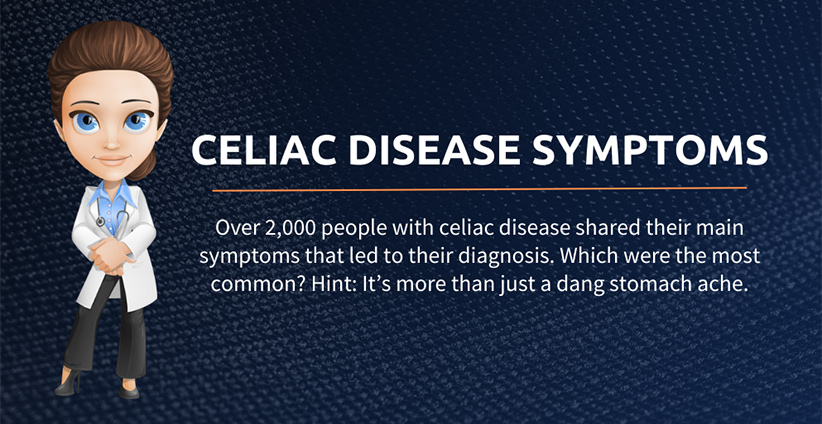Back in April of 2013, I asked my growing celiac community to share with me their celiac disease symptoms that led to a diagnosis. Based on almost 200 responses, I created this infographic, which has been shared (and stolen) thousands of times over the years. I have personally heard from many people who let me know that image actually helped them get diagnosed. Cool.
Here we are in January of 2024 (how the hell have 11 years passed that fast?!) and it’s time for an update. Not only did I want more input but I wanted to fine-tune it a bit and bring it up to date. So a few weeks ago, I reached out to the celiac community on Instagram, Facebook, Reddit, and my website, and again asked what their celiac disease symptoms were pre-diagnosis.
This time, I heard back from over 2,000 people (yowsa!) who shared their various symptoms. My team worked together to aggregate all of the data and then put our creative caps on. The infographic at the end of this post is the result of our work. Here is a quick glance at it:
I want to delve into the intricacies of celiac disease, emphasizing the importance of recognizing the most common celiac disease symptoms. The goal here is to enlighten people about the less-known manifestations of this condition and to encourage those experiencing these symptoms to seek medical testing for celiac disease. In other words, the celiac diagnosis rate sucks and I want to change that so people do not have to suffer needlessly.
The Misunderstood Spectrum of Celiac Disease Symptoms in 2024
Celiac disease is often pigeonholed as a gastrointestinal disorder, primarily associated with stomach pains, diarrhea, and bloating. And while those symptoms are certainly prominent, the responses we’ve collected paint a more diverse and complex picture. The myriad of symptoms extends far beyond the digestive system, affecting various parts of the body in ways that many might not immediately link to celiac disease.
Most Common Celiac Disease Symptoms in 2024 – Beyond the Digestive System
Our infographic, designed with clarity and accessibility in mind, illustrates the extensive range of symptoms. Here’s a glimpse into some of the most common celiac disease symptoms that are frequently overlooked:
- Fatigue and Weakness: A significant number of respondents reported chronic fatigue and weakness, symptoms that are often misattributed to other lifestyle factors or disorders.
- Dermatological Issues: Dermatitis herpetiformis, a skin rash, is a hallmark of celiac disease. Other skin-related symptoms include eczema and acne.
- Neurological Impairments: Some individuals experience neurological symptoms like headaches, brain fog, and even neuropathy.
- Mental Health Concerns: Issues such as anxiety, depression, and mood swings were frequently mentioned, underscoring the mental health impact of celiac disease.
- Joint and Muscle Pain: Unexplained aches and pains in muscles and joints can be a red flag for celiac disease.
- Dental and Oral Problems: Recurring canker sores, tooth enamel defects, and other dental issues are common yet often ignored symptoms.
- Reproductive Health Issues: Women, in particular, reported menstrual irregularities, infertility, and miscarriages, all potentially linked to undiagnosed celiac disease.
- Growth and Developmental Delays in Children: In pediatric cases, delayed growth and puberty can be crucial indicators of celiac disease.
Celiac Disease Symptoms – Final Thoughts
Celiac disease is a complex autoimmune disorder that demands greater awareness and understanding, especially concerning its diverse symptoms. I hope this new infographic, a result of extensive community input, serves as a valuable resource in illuminating the myriad of symptoms associated with celiac disease. I strongly encourage (i.e. beg) you to share this information, to help foster greater awareness and to promote early diagnosis and treatment.
Remember, acknowledging and understanding the most common celiac disease symptoms is not just about improving individual health; it’s about generating a more informed and empathetic community that recognizes the full spectrum of this condition. Let’s work together to bring light to the hidden aspects of celiac disease and support those who live with it every day.
Here is the infographic again. If you’d like the hi-res version, simply click on it and the larger image will open in a new tab. Simply save (and share) that image. Many thanks in advance.
If you’d like to see the complete list of symptoms, from most-mentioned to least-mentioned, head on over to https://glutendude.app/celiac-symptoms-2024.
Peace,
GD








THANK YOU, THANK YOU, THANK YOU, Dude!! This is fantastic, and I plan to share it with the world! Well, at least the celiac support group that I run! And I shall also make sure doctors see this info. You are simply thee best — and — wait for it — you use the Oxford comma! YAY!!!!
Thanks Jane.
[looking up what Oxford comment is now]
Looking at that chart, I’m reminded that I tried multiple times to tolerate SloFe because I was anemic. I could never tolerate it. The first time someone suggested it to me was around 2002 I think. Then about every two years after that. The diagnosis didn’t arrive, despite seeing a gastro, until 2017. He said my gas was from “too many carbs.” smh Yeah, you almost had that right… but which ones? 🙂 lol
Anyway, I didn’t find the modern Iron pills such as NovaFerrum until last year. No doctor directed me to it. They still say SloFe like myna birds.
Thank you for the information! I plan on sharing with my Celiac Support Group at our meeting next week. Thank you for all you do for the Celiac community!
Awesome!
Thank you for the good summary! But…
Its a pity that CONSTIPATION is not mentioned here, although it is also a frequent symptom. Bowel movement can also be normal in adults. Both points should be mentioned from my perspective.
I think this point is important, because this misconseption might prevent CD diagnosis in many cases!
Constipation is a symptom my hole family has! Really important to mention.